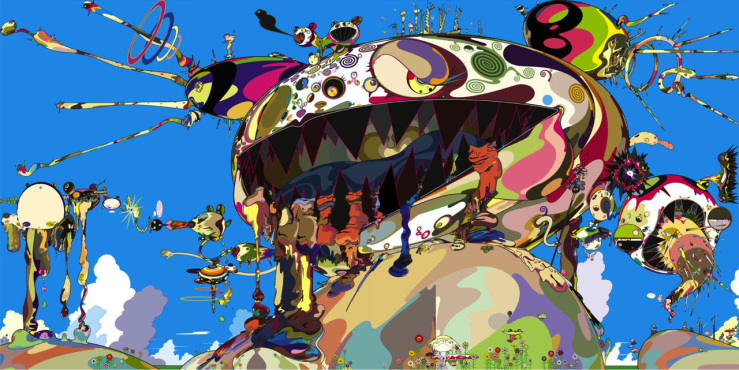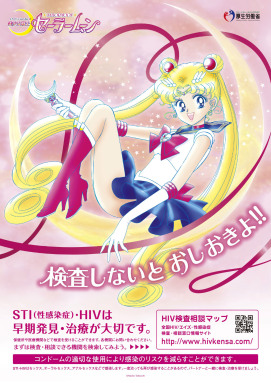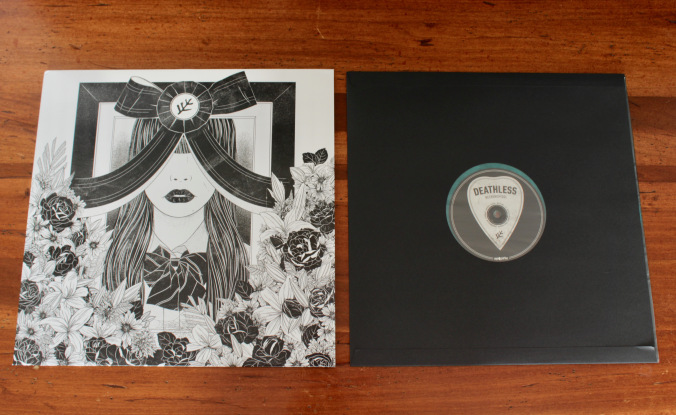By Hatje Cantz and Gregor Jansen, edited by Margrit Brehm for the Ursula Blickle Foundation, Kraitchal
“ We want to see the newest things.
That is because we want to see the future,
even if only momentarily. It is the moment
in which, even if we don’t completely
understand what we have glimpsed,
we are nonetheless touched by it.
This is what we have come to call ‘art’.”
Takashi Murakami, A Theory of Super Flat Japanese Art, 2000.
 Takashi Murakami, Tan Tan Bo Puking – a.k.a. Gero Tan, 2002
Takashi Murakami, Tan Tan Bo Puking – a.k.a. Gero Tan, 2002
“ Japonism is nothing more nor less than a revolution in the way of seeing european peoples,” – Edmond de Goncourt (diary entry – 18 April 1884)
The modern Japanese style still reverberates from the early Japanese painting traditions. It was at the time seen by the Occident as exotic pictorial idioms. Placelessness from a composition point of view to placelesness from a cultural point of view, it was a ‘floating, transient world onto which the 19th century was able project its escapist desires’.
I do not believe that the Japanese art culture has shifted away from this canon, – ‘it is no coincidence that a densely populated state on a small area of land, characterised by high-tech and excessive consumerism, is producing an art that instrumentalises the global flood of images for its own purposes and by balancing-act between high and low art, is defining positions that bring together intellectual relevance and popular appeal.’ The complete invasion of constructed imagery (as I don’t believe they all deserve to be named ‘art’) encourages the projection of personal fantasies on their surrounding – a result of monotoned routines.
As a European, Japan (that I have never visited) appears to me as this IRL virtual world – a nice oxymoron here. With a culture of over-marketing and prospering consumerism, the boundaries between fiction and non-fiction seem inexistent (almost echoing the greek mythology) . The use of anime characters in public health campaigns and advertisement confirms this statement.
 Sailor Moon against the syphilis outbreak – www.japantimes.co.jp
Sailor Moon against the syphilis outbreak – www.japantimes.co.jp
The book “The Japanese Experience – Inevitable” presents the japanese visual scene categorised between two school of which Takashi Murakami and Yoshimoto Nara may be regarded as the most popular representative.
It explores the universe and practices of :
Takashi Murakami
Kaikai Kiki Co. Ltd.
Mr.
Aya Takano
Masahiko Kuwahara
Yoshimoto Nara
Hiroshi Sugito
Shintaro Miyake
Jun Hasegawa
[It was only towards the end of the book that one question rose – to someone ignorant of the Japanese culture (as myself), these asian patronyms leave the notion of gender in the air. This allows an objective genderless analyses of the artist’s practices. Does this influence the western perception of extreme-oriental artists and feminism in Japanese art? – to be explored]
OTAKU CULTURE – “or the generation-spanning immersion in the illusory world of the manga”
Characterised by a lack of communication skills to relate to the outside world and a refusal to become an adult, i.e. to become totally integrated into the system.
This infantilisation of society increases their manipulability and is utilised as a compensation mechanism by the post-capitalist economic system for more profit.
NEW POP – or J-pop
Appeals to subculture influenced by manga, anime, pop music and the World-Wide-Web. Murakami’s KaiKai KiKi Co., Ltd uses merchandising and distribution strategies to reach New Pop’s origins outside the confines of museum.
Murakami’s art uses a conglomeration of creativity, production, distribution, economy, theory, marketing, contemporaneity for a fixed objective.
The Super Flat Manifesto, 2000 – ” ‘Super flatness’ is an original concept of Japanese who have been completely Westernised.”
Hiroshi Sugito organises his exhibitions in ways to tell a story with no beginning and no end. His work exhibited comment and reflect on each other.
***
Overall, Japan’s visual culture can be perceived as an exacerbated reflection of our society. Everything is exaggerated, no shame, no moral taboo of over-consuming; every social norm and insecurities can be exploited as marketable data. Resembling to a large-scale social experiment, the Japanese communication methods have a lot to teach us.
Advertisements Share this:




